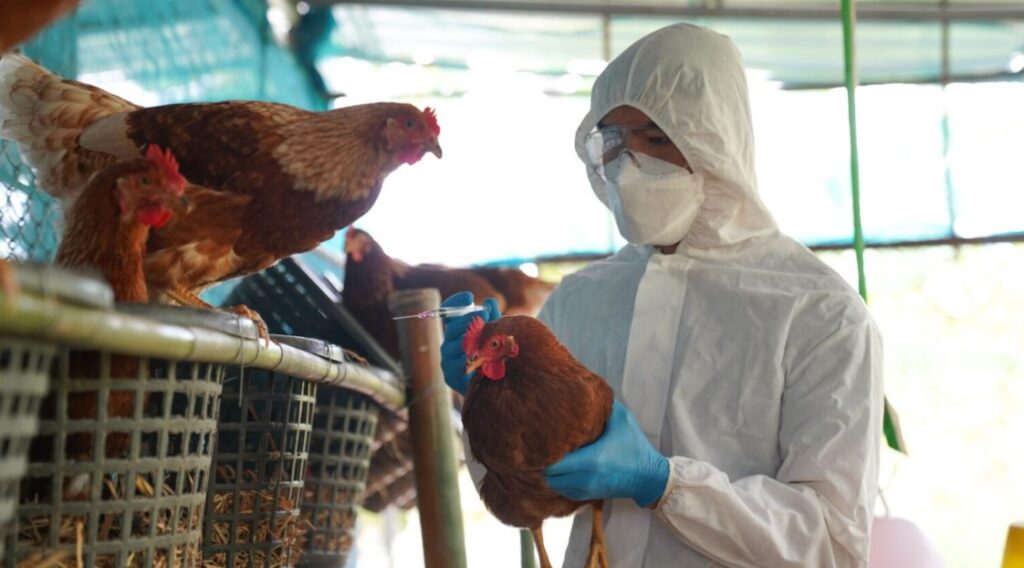
Big Cats Die of Bird Flu
A deadly Bird Flu Virus has recently swept through a sanctuary in Dunlap, Tennessee, and killed as many as 40 large cats such as tigers, lions, and cougars. This has brought concern about the virus transmission with wild animals and also its effect on our pets and human beings. As a result of this precaution, it is more important than ever to take Bird Flu precautions. In this article, we will also highlight the reasons why these precautions are crucial, provide practical advice on how to safeguard your animals and analyze the effects of the bird flu virus on animals and people.
What is Bird Flu and How Does It Affect Animals?
Bird Flu also known as Avian Influenza is an infectious disease of birds. It is cause by Type A influenza viruses with different strains such as H5N1 and H7N9 recently making the news. Though Bird Flu mainly affects birds, especially poultry, some strains are pathogenic to other animals, both wild and domesticated mammals.
Virus in Cats: A Growing Concern
Recently at a sanctuary in Dunlap, big cats including tigers and cougars found dead with a reported cause of death being H5N1 Bird Flu. These cats could have got the virus after they interacted with the wild birds or their feces which are agents of spreading the virus. This has to do with an update that bird flu can and occurs in cats and lead to severe respiratory disease and sudden death and may cause injury to the nervous system that could be irreversible. This leads to several questions regarding Bird Flu in wildlife and Bird Flu precautions that are need now more than ever before.
You can learn more about Bird Flu in animals here CDC’s page on avian influenza is here.
Bird Flu Virus Precautions: How to Protect Your Pets and Family
With the current Bird Flu precautions in Colorado and Missouri Bird Flu cases reported, it is important to do everything possible to avoid Bird Flu. Bird Flu measures are important to curb the spread of the disease and protect the public.
Step 1: Avoid Contact with Wild Birds and Their Droppings
The virus spreads mainly through wild birds. As a result, it is important not to let your pets go outside, particularly if there have been cases of Bird Flu in your area.• Avoid exposure of pets, particularly those that stay outside, to the rain.• Disinfect bird feeders, fountains, and any other equipment that is placed outside in variety, especially in terms of bird dung.• Do not let your pets wander in places that are inhabited by birds especially the wetlands, marshes, or places with the acknowledged presence of migratory birds. There have been confirmed Bird Flu precautions. If you live in areas like Dunlap, Colorado, or Missouri, where precautions have been reported, it’s important to:
- Keep pets, especially outdoor animals, inside.
- Clean bird feeders, baths, and any other outdoor equipment to prevent contamination from bird droppings.
- Prevent your pets from roaming in areas with high bird populations, such as wetlands, marshes, or areas known for migratory birds.
For more specific information on how to avoid contact with wild birds, please read this CDC article on Bird Flu prevention here.

Step 2: Ensure Proper Hygiene and Sanitation
The first and the most relevant preventive measures against bird flu are washing hands and keeping personal and surrounding areas clean. The virus is transmitted by contact with infected animals or their droppings or by contact with contaminated objects or articles. By following these hygiene practices, you can reduce the risk of transmission:
- Disinfect surfaces: Wash your pet’s bedding, toys, food, water bowls, or other objects that your pet touches with a bleach solution or any other disinfectant if you have been outside or close to wildlife.• Use hand washing after touching animals feeding them, or cleaning their enclosure, especially if you may come across infected animals.• This is especially important if you think your pets have been exposed to the virus – wash your hands with soap and water, use gloves when touching your pets, cleaning cages, or cleaning up after them. Animals, their droppings, or contaminated surfaces. By following these hygiene practices, you can reduce the risk of transmission:
- Disinfect surfaces: Use a bleach solution or other disinfectant on surfaces your pets come in contact with, especially if you’ve been outside or near areas with wildlife.
- Wash your hands thoroughly after handling animals or cleaning up after them, especially if there’s a possibility of exposure to infected animals.
- Wear gloves when handling your pets, cleaning cages, or cleaning up after them, particularly if you suspect they have been expose to the virus.
Step 3: Consult Your Veterinarian
So, if you have any doubts that your pet has been in contact with Bird Flu, then it is time to call the veterinarian.• Cough and nasal secretion might have been expose to Bird Flu, it is crucial to contact a veterinarian immediately. While Bird Flu in milk has not been identify as a significant risk, pets can show symptoms similar to those found in humans, including:
- Fever
- Coughing and nasal discharge
- Lethargy
- Loss of appetite
- Breathing difficulties
Any of these symptoms should be take seriously, especially by consulting your veterinarian, and the earlier the better to avoid instances where death or other complications are inevitable. There is a lot of information available from reliable animal health websites such as Health Boosters to know how to treat the symptoms and where to get assistance.
Step 4: Monitor Your Pets’ Health Regularly
In other words, the role of the subject and the attitude to it are changing; and it’s high time to stay vigilant. Pay attention to your pets, and if they are showing any sign of sickness, especially respiratory problems, lack of energy, or strange behavior. Signs should be recognize at an early stage to avoid spreading the virus to other animals. To avoid getting infecte with Bird Flu, ensure that you read local health bulletins or alerts when you live in an area that has the disease.
To get more information on Bird Flu symptoms and new information about how to protect your pets, check the CDC or WHO websites. You can also browse through the Health Boosters animal health section for more information.
Bird Flu and Dairy Cows: Should You Be Concerned?
One question people have about the Bird Flu virus in milk is whether the virus affects dairy cows or the milk they produce.
Still, local health departments, such as the CDC and WHO, pay close attention to how the virus affects various species. If you live in areas that have been affected by Bird Flu like the Canada Bird Flu case in Ontario or Colorado, do not take raw milk because, through pasteurization, all dangerous pathogens including the Bird Flu virus are killed.
For detailed information about Bird Flu in milk, go to the CDC’s Food Safety and Animal Diseases official page here.

The Global Impact: Bird Flu Precautions and Response
Bird Flu epidemics report In many countries over the years for instance the H5 Bird Flu that was reported in 2024, and is still causing problems affecting the poultry markets and wildlife. In the U.S., there has been concern over Bird Flu in Missouri, Colorado, and New York City (NYC).
These precautions have had drastic impacts in terms of loss of poultry business revenues as well as fear of inter-species transmission. The CDC director Bird Flu has encouraged people to be more informed and to get ready. Local health departments and wildlife agencies are engaging actively in restricting the increase and the impacts on human wellbeing.
To learn more about Bird Flu precautions, click on the CDC’s current Avian Influenza news here.
Key Features of Bird Flu: What You Need to Know
- Spread: It is contract by either direct contact with infected birds or through contact with any object or surface that has been in contact with infected birds. Wild birds especially the migrating ones are the main routes through which the virus spreads.
- Symptoms in Animals: In cats, symptoms are fever, dyspnoea, anorexia, and lethargy. It can cause death, especially sudden death occasionally.
- Impact on Humans: In humans, H5 Bird Flu cases are still few, but infected individuals who handle dead animals or animal feces are at risk of getting the disease. The effects of the virus in men include fever, respiratory problems, and pneumonia.
- Global Monitoring: Officials including the CDC are watching the development since Bird Flu is now affecting both wild and domestic birds and chickens.
FAQ: Common Questions About Virus
Q: What consequences does Bird Flu have on humans?
A: The virus leads to flu-like illness and in severe cases leads to pneumonia, chest infection, fever, cough, and body aches. That is why human-to-human transmission is still relatively unusual.
Q: Is it safe to take milk during the Bird Flu breakout?
A: Although Bird Flu in milk has not been established as a major issue, it is still safest to avoid raw milk from regions infected with the virus. Pasteurization eliminates any possible pathogen that may be there.
Q: How can I safeguard my pets from Bird Flu?
A: Avoid taking pets outside especially when Bird Flu is around. Sanitize the house, wipe the furniture, and always wash your hands as a way of preventing the spread of germs. In any case, we need to consult with a veterinarian if the pet has symptoms.
Q: Is Bird Flu a danger to other animals other than birds?
A: Although Bird Flu is not common amongst mammals, some are susceptible to the virus such as large cats. Your pets should also be kept away from the virus especially where the virus has been confirmed to be circulating.
Conclusion: Proactive Measures for Protecting Pets and Humans from Bird Flu
This should be a wake-up call for Dunlap and other regions around the globe to rein in Bird Flu as it spreads to animals such as large cats and threatens human life.
To learn more about Bird Flu prevention, the newest precautions, and health tips, do Health Boosters. Be aware, be safe, and do everything necessary to protect yourself and your families from this constant health danger.
To get the latest information, visit the CDC’s Bird Flu resource page and keep in touch with health professionals.
